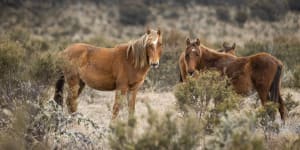The practice resumed in NSW after 20 years of bitter debate following an explosion in last year.

Ecologists say horse herds must be quickly reduced to prevent the extinction of threatened native species.Alex Ellinghausen
Aerial shooting began with a two-day preliminary operation last November which saw shooters working from two helicopters kill 270 horses. An independent veterinarian and the RSPCA observed proceedings and then inspected 43 dead horses on the ground.
During the first cull it took an average of 7.5 shots per horse and the median time from shooting to death was five seconds,according to a statement by the Department of Climate Change,Energy,the Environment and Water,which has responsibility for National Parks and Wildlife.
All horses shot in the initial operation were killed.
From November 2021 to March 2024,4196 horses have been removed from the park.
A southern section of the park from the Victorian border up to parts of the Alpine Way road to Jindabyne was closed from March 4 to March 28,while much larger northern zone will be closed from April 4 until October 4 to allow the culling to continue safely.
The closure extends a regular winter shutdown of parts of the park that normally runs from the June to October long weekends.
Popular tourist attractions like Mount Kosciuszko and the Yarrangobilly Caves and the alpine resorts will remain open.
Aerial shooting is still opposed by some brumby advocacy groups and members of parliament.
During a NSW parliamentary inquiry hearing on Wednesday,National Parks and Wildlife Service head Atticus Fleming said scientific advice was that the only way to reduce horse numbers faster than the mobs bred was by aerial culling.
He said those who were calling for aerial culling to end,which include Nationals MP Wes Fang and the Animal Justice Party’s MP’s Emma Hurst,were in effect calling for the park to be surrendered to other invasive species,which was likely to lead to the extinction of some already vulnerable native species.
Hurst supports non-lethal control measures such as contraception and capture and rehoming of brumbies,while Fang called for it to end until it could be properly recorded by technologies such as body cams and cameras attached to helicopters.
Brumby advocate Lynette Sutton called for funding to be provided so that accredited horse charities could buy land,feed,veterinary care and equipment to look after captured wild brumbies.
She told the hearing that some people had volunteered to rehome the brumbies.
TheHerald has obtained a list of preferences provided to NPWS by a horse advocacy group.
“Good quality size,type and temperament is requested,frightened is fine but don’t want any that are too unsettled for transport that may harm themselves or others during transport,” it says.
“Good variety of colour Roan,Grey,Creamy,Taffy (Blonde mane and tail),Black and a small amount of bay and Chestnut.
“We are confident you will be able to meet our requests due to the ramping up of your culling program and the numbers of brumbies that are stated to be in the KNP.”
An NPWS spokesperson said such specific requests could slow down the process.
The horses are among a total of 13,000 feral animals removed from the park and its surrounds by the department,including over 8000 deer,in the three and a half years to the end of last year. The majority of those animals were shot from the air. Across the state the number is around 140,000.
The Morning Edition newsletter is our guide to the day’s most important and interesting stories,analysis and insights..